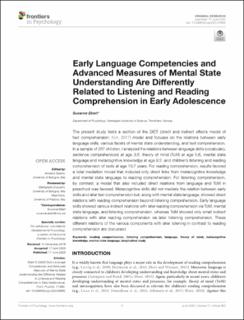Early language competencies and advanced measures of mental state understanding are differently related to listening and reading comprehension in early adolescence
| dc.contributor.author | Ebert, Susanne | |
| dc.date.accessioned | 2020-09-28T09:08:35Z | |
| dc.date.available | 2020-09-28T09:08:35Z | |
| dc.date.created | 2020-04-20T11:11:17Z | |
| dc.date.issued | 2020 | |
| dc.identifier.issn | 1664-1078 | |
| dc.identifier.uri | https://hdl.handle.net/11250/2679900 | |
| dc.description.abstract | The present study tests a section of the DIET (direct and indirect effects model of text comprehension; Kim, 2017) model and focuses on the relations between early language skills, various facets of mental state understanding, and text comprehension. In a sample of 267 children, I analyzed the relations between language skills (vocabulary, sentence comprehension) at age 3;6, theory of mind (ToM) at age 5;6, mental state language and metacognitive knowledge at age 9;2, and children’s listening and reading comprehension of texts at age 13;7 years. For reading comprehension, results favored a total mediation model that included only direct links from metacognitive knowledge and mental state language to reading comprehension. For listening comprehension, by contrast, a model that also included direct relations from language and ToM in preschool was favored. Metacognitive skills did not mediate the relation between early skills and later text comprehension but, along with mental state language, showed direct relations with reading comprehension beyond listening comprehension. Early language skills showed various indirect relations with later reading comprehension via ToM, mental state language, and listening comprehension, whereas ToM showed only small indirect relations with later reading comprehension via later listening comprehension. These different relations of the various components with later listening in contrast to reading comprehension are discussed. | en_US |
| dc.language.iso | eng | en_US |
| dc.publisher | Frontiers Media | en_US |
| dc.rights | Navngivelse 4.0 Internasjonal | * |
| dc.rights.uri | http://creativecommons.org/licenses/by/4.0/deed.no | * |
| dc.title | Early language competencies and advanced measures of mental state understanding are differently related to listening and reading comprehension in early adolescence | en_US |
| dc.type | Peer reviewed | en_US |
| dc.type | Journal article | en_US |
| dc.description.version | publishedVersion | en_US |
| dc.source.journal | Frontiers in Psychology | en_US |
| dc.identifier.doi | 10.3389/fpsyg.2020.00952 | |
| dc.identifier.cristin | 1807091 | |
| dc.description.localcode | Copyright © 2020 Ebert. This is an open-access article distributed under the terms of the Creative Commons Attribution License (CC BY). The use, distribution or reproduction in other forums is permitted, provided the original author(s) and the copyright owner(s) are credited and that the original publication in this journal is cited, in accordance with accepted academic practice. No use, distribution or reproduction is permitted which does not comply with these terms | en_US |
| cristin.ispublished | true | |
| cristin.fulltext | original | |
| cristin.qualitycode | 2 |
Tilhørende fil(er)
Denne innførselen finnes i følgende samling(er)
-
Institutt for psykologi [3140]
-
Publikasjoner fra CRIStin - NTNU [38672]

